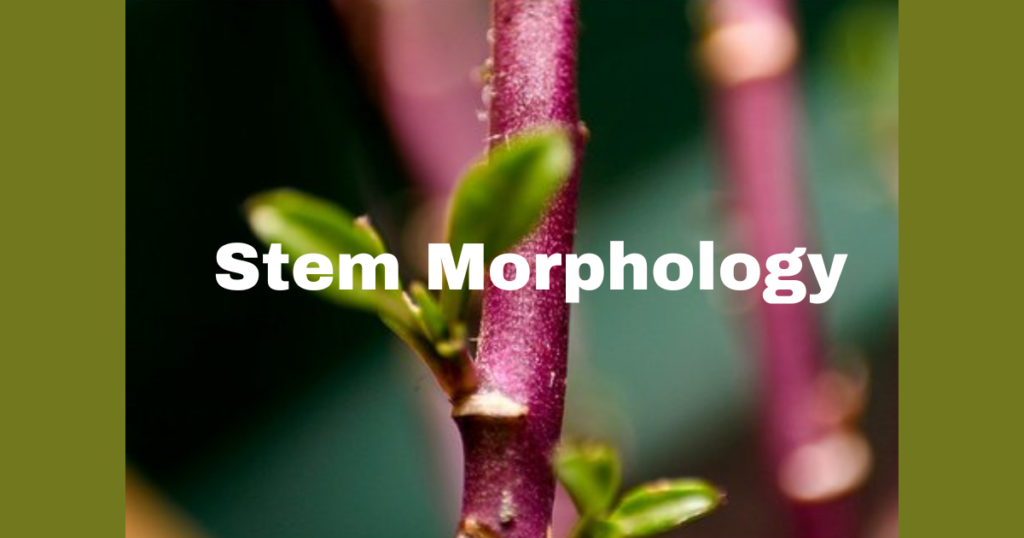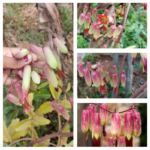Stem Morphology is a vital part of Flowering Plants, playing a key role in their growth, strength, and overall survival. It serves as the plant’s backbone, supporting the leaves, flowers, and fruits while acting as a highway for transporting water, nutrients, and food. What makes stems truly fascinating is their ability to adapt and modify in response to their environment, showcasing the incredible diversity of plant life. In this blog, we’ll take a closer look at the structure and functions of stems, uncovering their unique features and the ways they help plants flourish in different conditions.
Characteristics of Stem
- Stems provide support to the plant and keep it standing tall so it can reach for the sunlight.
- Stems transport water and nutrients from the roots to the leaves and also move the sugars produced in the leaves to other parts of the plant.
- Stems move upward and away from the ground to reach for the light, which means they are positively phototropic and negatively geotropic.
- Stems develop from the plumule and epicotyl regions of the embryo.
- Stems are made up of parts called nodes and internodes, and they have a terminal bud at the top.
- Young stems start off green and can make their own food through photosynthesis, but as they grow older, they change color.
- Certain stems have hairs made up of multiple cells.
- Mature plants have flowers and fruits that grow on their stems and branches.
Anatomy of Stem
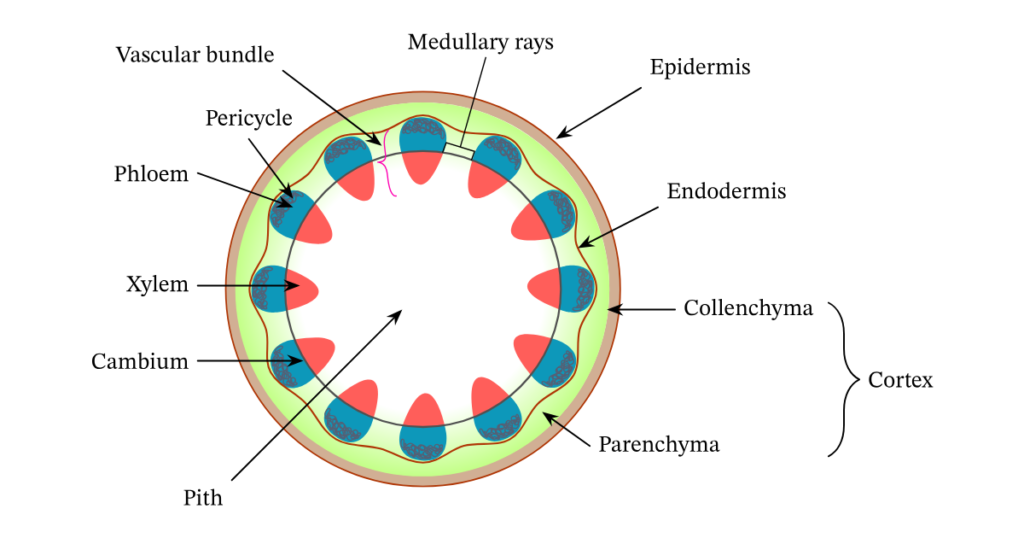
1. Epidermis
The epidermis is the outermost cell layer on the stem, serving as a protective barrier for the plant. It usually consists of a single layer of closely packed cells that protect against damage and help keep water from escaping too quickly.
Some important features of the epidermis are:
- The epidermis keeps the inner parts of the stem safe from things like germs, harmful sunlight, and physical harm.
- Many plants have a waxy layer known as the cuticle on their epidermis, which helps to keep water from evaporating too much.
- In certain plants, the epidermis has tiny openings called stomata that are crucial for exchanging gases like oxygen and carbon dioxide, as well as for the process of transpiration.
- The epidermis can also have hair-like structures called trichomes that help protect the plant from being eaten by animals, reduce water loss, and shield it from strong sunlight.
2. Cortex
The cortex is a layer of tissue found just below the outer skin, or epidermis, of a plant’s stem. It consists of different layers of cells that have various functions based on the type of plant and what it needs. The cortex is important for giving the plant support, storing nutrients, and in some cases, helping with photosynthesis.
Here are some important points about the cortex:
- The cortex mainly consists of parenchyma cells, which are living cells that have thin walls and big vacuoles.
- In certain plants, there are also collenchyma cells that add extra support because their walls are thicker.
- The parenchyma cells in the cortex store nutrients, water, and starch, supporting the plant’s health and growth.
- When collenchyma cells are present, they provide strength and flexibility, helping the plant resist strong winds.
- In green stems, the cortex has chloroplasts that allow the plant to perform photosynthesis.
- The cells in the cortex usually have gaps between them, which helps with gas exchange in the stem.
3. Vascular Bundles
Vascular bundles are important parts found in the stems of flowering plants. They facilitate the transport of water, nutrients, and food throughout the plant. These bundles are made up of special tissues grouped together, which include the xylem, phloem, and sometimes cambium, especially in dicots.
Key Components of Vascular Bundles:
a) Xylem
The Xylem is a special type of tissue found in vascular plants that helps move water and minerals from the roots up to the rest of the plant. It also gives the plant strength because its cells have thick walls.
Functions of Xylem
- It moves water and nutrients that are dissolved from the roots up to the stems and leaves.
- It makes the plant stronger so it can grow tall and straight.
Composition of Xylem
- Tracheids are elongated, slim cells that have pointed ends, helping water move through small openings in their walls.
- Vessels are long, tube-shaped parts mostly found in flowering plants, and they help move water around really well.
- Xylem fibers are strong cells with thick walls that help give plants their shape and support.
- Xylem parenchyma is made up of living cells found in xylem tissue, and their main job is to store food and water.
Types of Xylem
- The primary xylem is created when a plant is just starting to grow. The initial structure that develops is known as protoxylem, which is smaller in size and less durable. Later on, the metaxylem develops, and it has bigger and stronger cells.
- Secondary xylem is present in woody plants and contributes to the thickening of stems and roots, forming structures like wood.
b) Phloem
Phloem is a type of tissue in plants that helps move the sugars made during photosynthesis from the leaves to other areas of the plant. It is really important for spreading nutrients throughout the plant.
Functions of Phloem
- Food, particularly sugars produced in the leaves during photosynthesis, is transported to various parts of the plant. This helps the plant grow, store energy, and stay healthy.
Composition of Phloem
- Sieve tubes are long, tube-shaped parts made up of linked sieve tube elements that help transport food throughout plants.
- Companion cells help sieve tubes work properly by supporting their functions and controlling how food materials are added and removed.
- Phloem fibers help give strength and support to the phloem tissue.
- Phloem parenchyma helps keep and move food and nutrients around.
c) Cambium
Cambium is a special layer of tissue in plants that helps them grow thicker. You can find it in the stems and roots, especially in dicots and gymnosperms. This layer is really important for the plant’s secondary growth, which means it helps the stems and roots get bigger around.
Location
Located between the xylem and phloem in the vascular bundles of dicots.
Function of Cambium
- Secondary growth makes the plant grow thicker by creating more wood (called secondary xylem) on the inside and more phloem on the outside.
- In woody plants and trees, the cambium layer generates new growth rings annually.
Types of Cambium
- The vascular cambium helps make more xylem and phloem, which allows the plant to grow wider.
- The cork cambium, also known as phellogen, creates protective layers like cork, which is part of the bark, and a secondary layer called cortex.
Related Blog – The Roots Morphology of the Flowering Plants
4. Pericycle
The pericycle is a thin layer of cells that is mostly found in the roots of plants and sometimes in their stems. It is located right under the endodermis and surrounds the vascular bundles. This layer is really important for helping plants grow and develop properly.
Key Features of the Pericycle:
Location
It is located in between the endodermis and the vascular bundles.
Functions of Pericycle
- Lateral root development takes place in the pericycle, facilitating the expansion of the root system and enhancing the plant’s stability.
- The pericycle helps in making the vascular cambium in certain plants, which supports the thickening of roots and stems as they grow during the secondary growth phase.
- Pericycle keeps important nutrients and other necessary materials.
5. Medulla
The medulla, also known as the pith, is the middle section of the stem in many plants. It consists of soft, spongy cells called parenchyma, and it serves various functions based on the type of plant and how mature it is.
Key Features of the Medulla:
Location
Located in the middle of the stem, surrounded by vascular bundles in dicot plants.
Functions of Medulla
- The pith holds important nutrients, water, and starch that help the plant stay healthy and grow.
- It helps move nutrients and water sideways throughout the plant.
- The pith helps give plants strength and keeps them stable, especially in plants that are soft and green.
6. Medullary Rays
Medullary rays are strips of parenchyma cells that stretch out between the vascular bundles in the stems and roots of plants. They go from the center pith to the outer layer, helping nutrients and water move sideways.
Key Features of Medullary Rays:
Location
The stem and root contain something special. They’re arranged in a circle between the xylem and phloem tissues.
Functions of Medullary Ray
- Lateral transport helps move water, nutrients, and food sideways throughout the plant.
- Medullary rays are special structures in plants that help store important things like nutrients, starch, and other materials that the plant needs to stay healthy and grow.
- Medullary rays help give support to the plant and keep its shape balanced from the center outwards.
Related Blog – Best Outdoor Plants for Home Garden
Types of Stems
Here are 3 main types of stems based on their Location:
1. Underground Stem
These stems are low to the ground and produce shoots that grow up above the soil. Their roots don’t go very deep. They mainly help the plant store food and stay alive during tough times. Also, these stems can help the plant reproduce without seeds.
Functions of Underground Stem
- The underground stems act like storage tanks, keeping important nutrients and food for the plant.
- These stems help the plant make new clones that are just like the original, allowing for asexual reproduction.
- They help plants survive tough seasons and bad weather by serving as structures for survival.
- Underground stems shield the plant from dangers such as animals that eat them, fires, and quick changes in the weather.
- They help plants grow and spread out over larger areas, which helps them take over new spaces.
Types of Underground Stem
Rhizomes
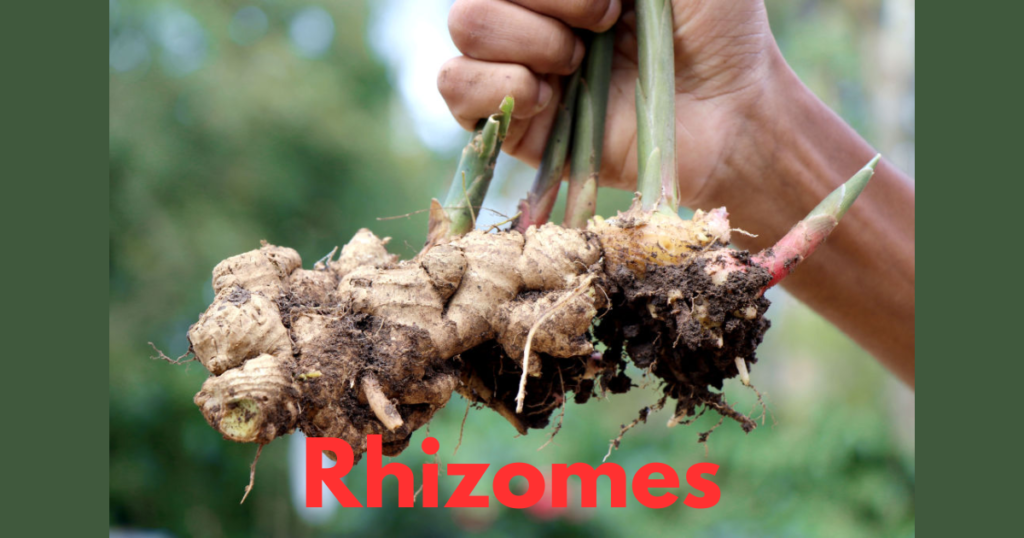
A stem that grows sideways and has leaves that look like scales, with clear bumps called nodes. From each node, new shoots grow up towards the sky, and roots dig down into the ground. Some plants with this kind of stem are ginger, Alocasia, and banana.
Bulb
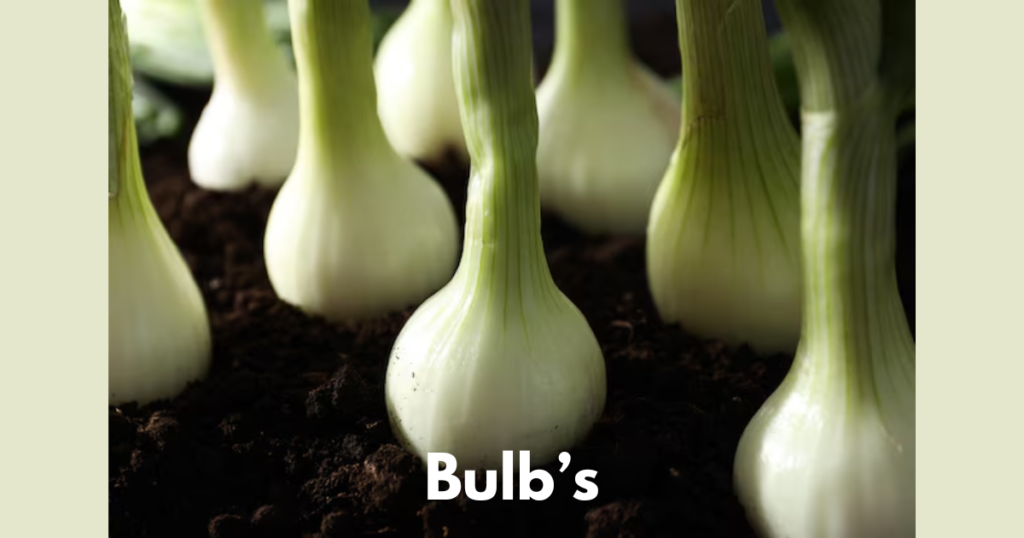
A small, upright plant that keeps starch in the ground. It has a short stem that stands up and is covered by thick, juicy leaves that help it store food. Some examples of this type of plant are onions and garlic.
Corm
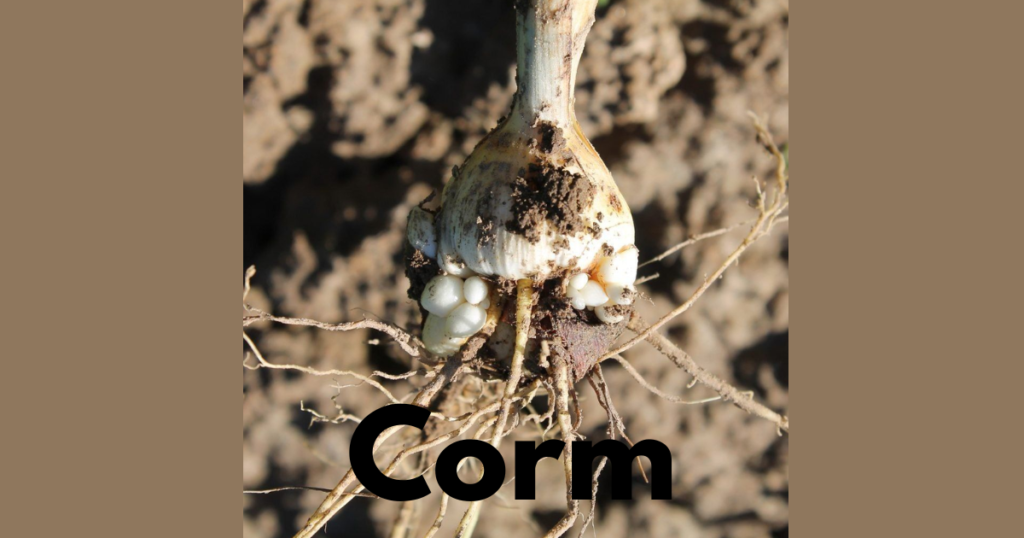
A small, straight plant with a sturdy, starchy stem that has thin, paper-like layers on the outside. Some examples of this type of plant are taro and Colocasia.
Stolon
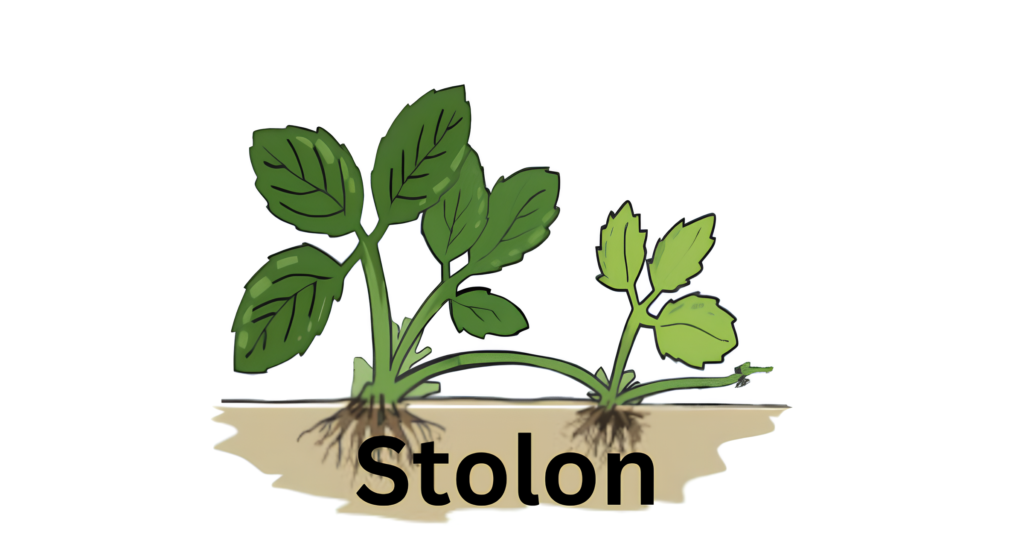
A horizontal stem that grows beneath the soil has noticeable bumps and long spaces between them. Usually, stolons grow above the ground, but some actually grow just under the surface. Strawberries and mint are good examples.
Tuber
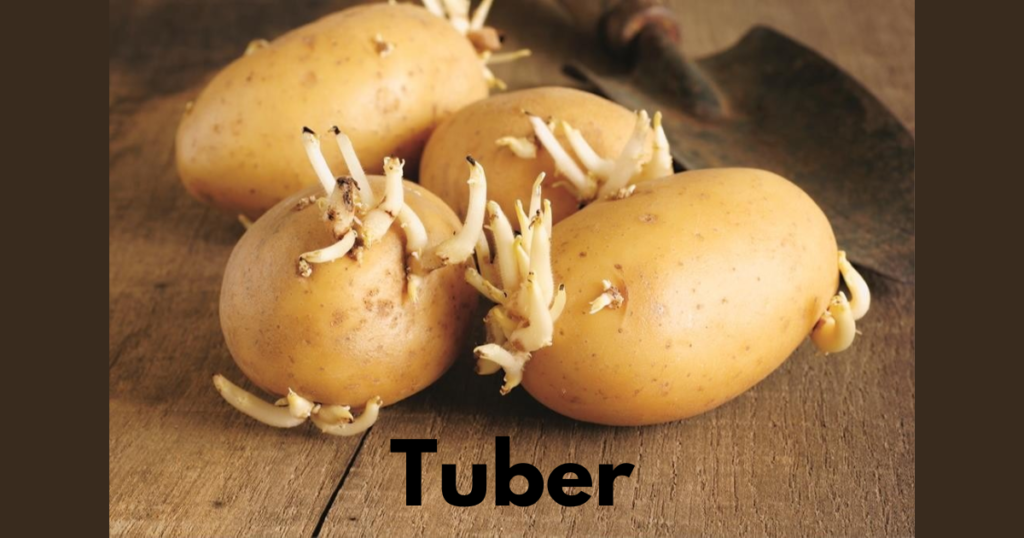
A tuber is a thickened, fleshy part of a plant that serves as a storage reservoir for nutrients. A famous example of a tuber is the potato.
2. Subaerial Stem
A subaerial stem is a type of stem that develops partly above and partly below the soil surface. Often referred to as creepers, these stems possess unique adaptations that allow plants to thrive in specific habitats. Subaerial stems play a crucial role in vegetative propagation and can also serve as food storage structures.
Functions of Sub-Aerial Stem
- Plants can reproduce without seeds thanks to their subaerial stems, which help them grow new plants through a process called vegetative propagation. When a branch or node breaks off from these stems, it can develop into a completely new plant.
- Subaerial stems are adapted with unique characteristics that enable plants to survive and thrive in particular environmental conditions.
Types of Sub-Aerial Stem
Runner
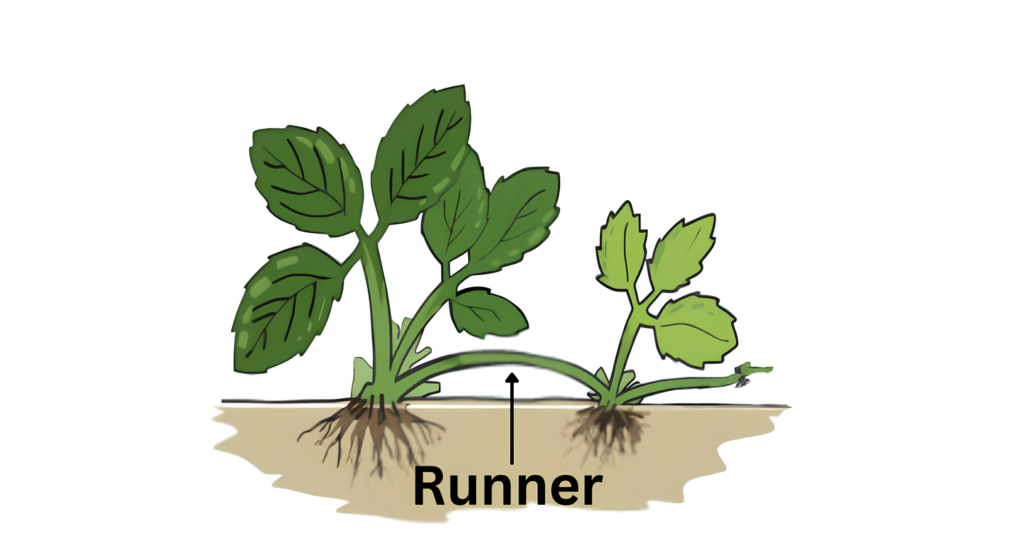
A runner stem is a type of stem that grows flat along the ground. It creates new plants at certain points called nodes, which helps the plant reproduce without seeds. You can often find runners in plants like strawberries, allowing them to spread out and grow in new spots nearby.
Offset
An offset stem is a short, horizontal stem that grows close to the bottom of a plant, often just above or below the ground. It creates new plants at its joints, helping the plant reproduce without seeds. You can often see offsets in plants like water lilies and some succulents, which helps them spread and grow in new areas.
Stolon
A stolon is a type of stem that grows sideways along the ground or just above it. It creates new plants at certain points called nodes, which helps the plant reproduce without seeds. You can often see stolons in plants like strawberries, which help the plant spread by producing new shoots that can grow into their own separate plants.
Sucker
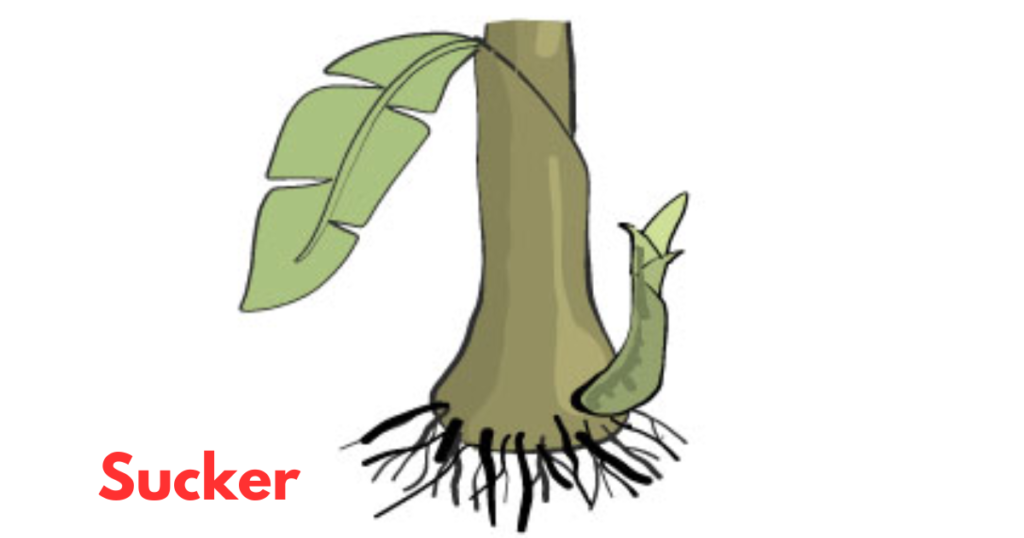
A sucker stem is a new shoot that grows from the bottom of a plant or its roots. It comes from sleeping buds that are found on the roots or close to the ground. These suckers can develop into separate plants, which helps the plant reproduce without seeds. For example, apple trees and blackberries often create sucker stems, allowing them to spread and grow more plants.
3. Aerial Stem
An aerial stem is a stem that grows above the soil surface. It is really important because it helps hold up the plant’s leaves, flowers, and fruits. This stem does a lot of things, like keeping the plant stable, helping with photosynthesis, and moving water, nutrients, and food around the plant. Some plants that have aerial stems are bamboo, sugarcane, and sunflowers.
Functions of Aerial Stem
- Aerial stems help plants climb by curling around something they can hold onto. Tendrils are thin, stringy parts of these aerial stems that are really important for helping plants grab onto and stay attached to things around them.
- Aerial stems help support weak, green stems so they can stand up straight.
- Some types of aerial stems can perform photosynthesis. Phylloclades are special kinds of stems that look like flat leaves and are designed specifically for this process.
- Some aerial stems can become thick and fleshy to store food. Bulbils are tiny, bulb-shaped parts of these stems that act like storage containers and can turn into new plants.
- Aerial stems can protect plants from animals that like to eat them by changing them into thorns. These thorns are tough, sharp, and pointy changes of the aerial stems.
- Aerial stems can help save water by changing into phylloclades. These are special types of stems that look like leaves and are designed to reduce water loss through a process called transpiration.
Types of Aerial Stem
Thorns
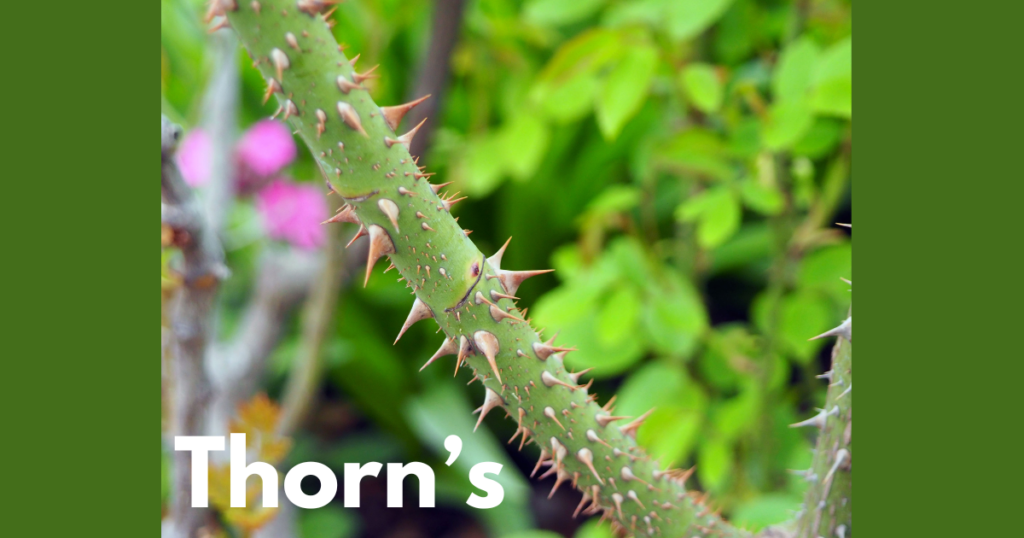
These changes to the stems are tough, wooden, and sharp, acting like a shield to keep the plant safe. A good example of this is the thorns that grow on rose bushes.
Tendril
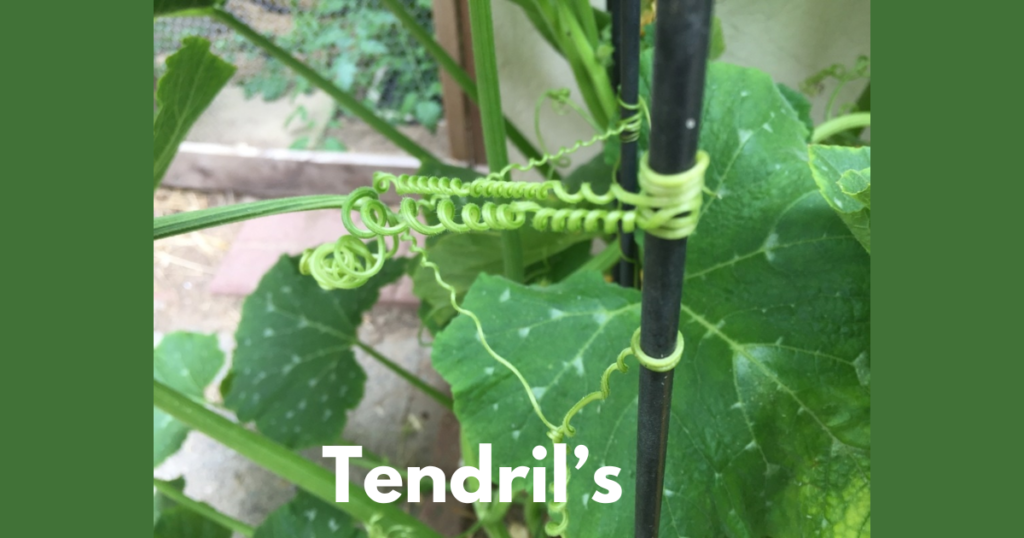
These stems are slender, twisting parts that allow plants to grip onto and climb up other surfaces for support.
Phylloclade
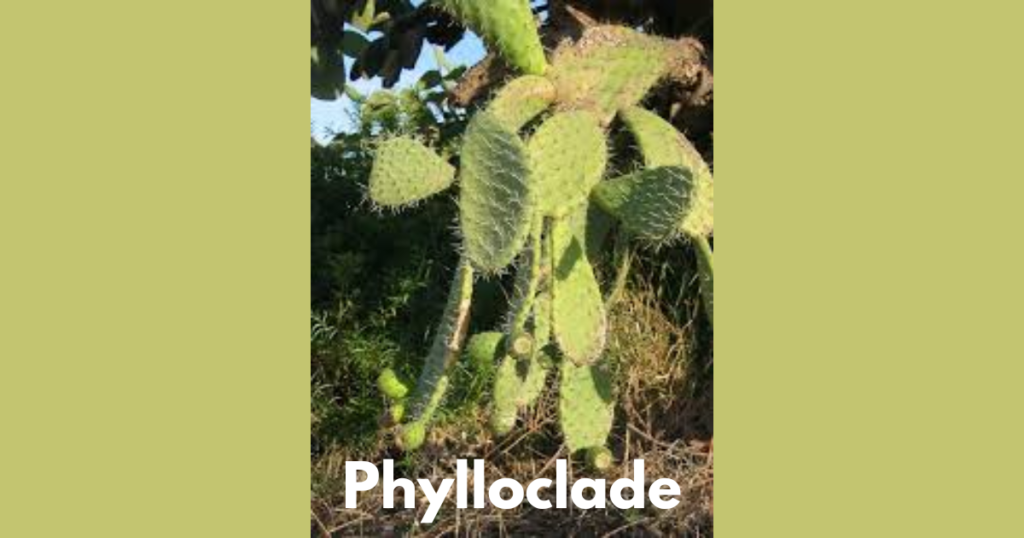
This kind of stem is green and can be flat or round, looking a bit like a leaf. It’s called a phylloclade, and it can do photosynthesis. You usually see it in plants that live in dry places, like xerophytes, which have very few or no leaves at all.
Cladode
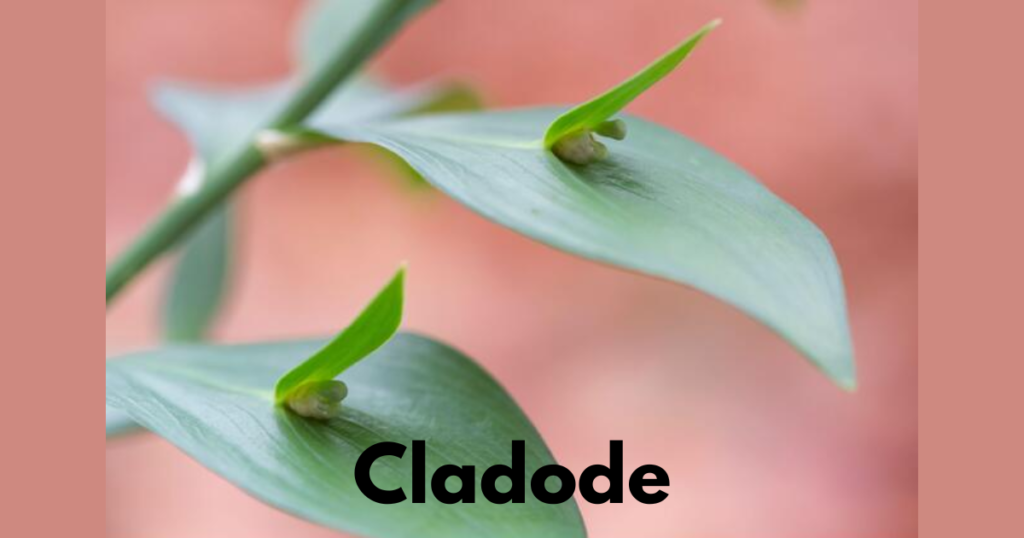
This is a changed version of the phylloclade that has one or more sections between the nodes.
Bulbil
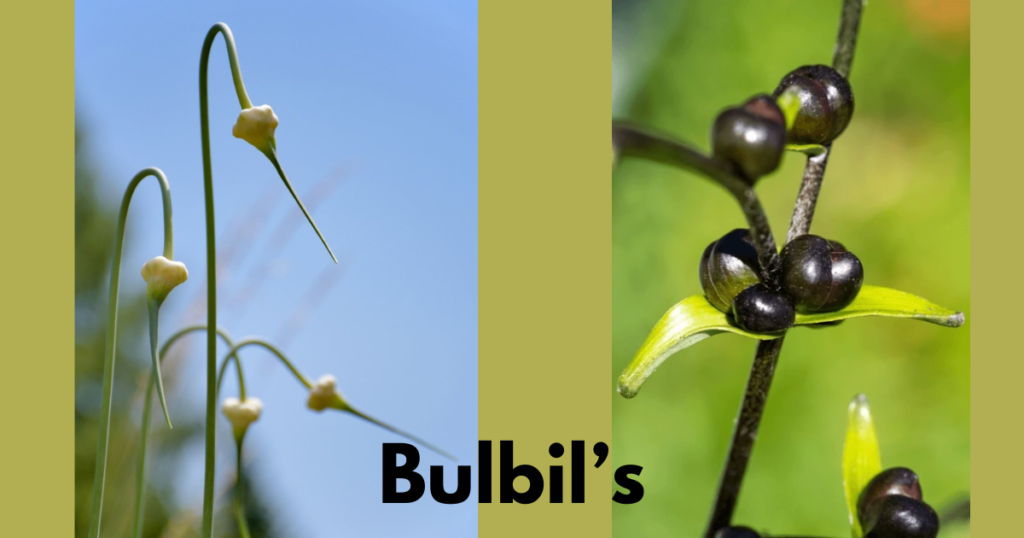
These stems are special axillary buds that change to become thick and round because they hold food. When they break off from the main plant and drop to the ground, they can sprout into new plants, helping the plant to spread and grow.
Functions of Stem
- Stems help hold up a plant’s leaves, flowers, fruits, and buds, giving them the support they need.
- Stems help carry water, minerals, and nutrients all around the plant.
- Stems can act as storage places for food. This is true for things like tubers, rhizomes, corms, and even the thick stems of trees and bushes.
- Green stems help the plant make its own food through a process called photosynthesis.
- Stems change to keep up with how the air moves, the amount of water, and nutrients they can get. They also play a big role in helping the plant catch sunlight.
FAQs
1. What is stem morphology in flowering plants?
Stem morphology looks at how the stems of flowering plants are built, their shapes, and how they change to help the plants survive. It focuses on the different features and changes in stems that allow them to do important jobs like holding the plant up, moving nutrients, storing food, and helping with reproduction.
2. Can stems perform photosynthesis?
In some plants like cacti and euphorbia, the stems do the job of photosynthesis, especially when there are no leaves or when the leaves are really small.
3. Why are underground stems considered stems and not roots?
Underground stems are different from roots because they have special parts like nodes, internodes, and buds. These stems store food and can also grow new shoots.

